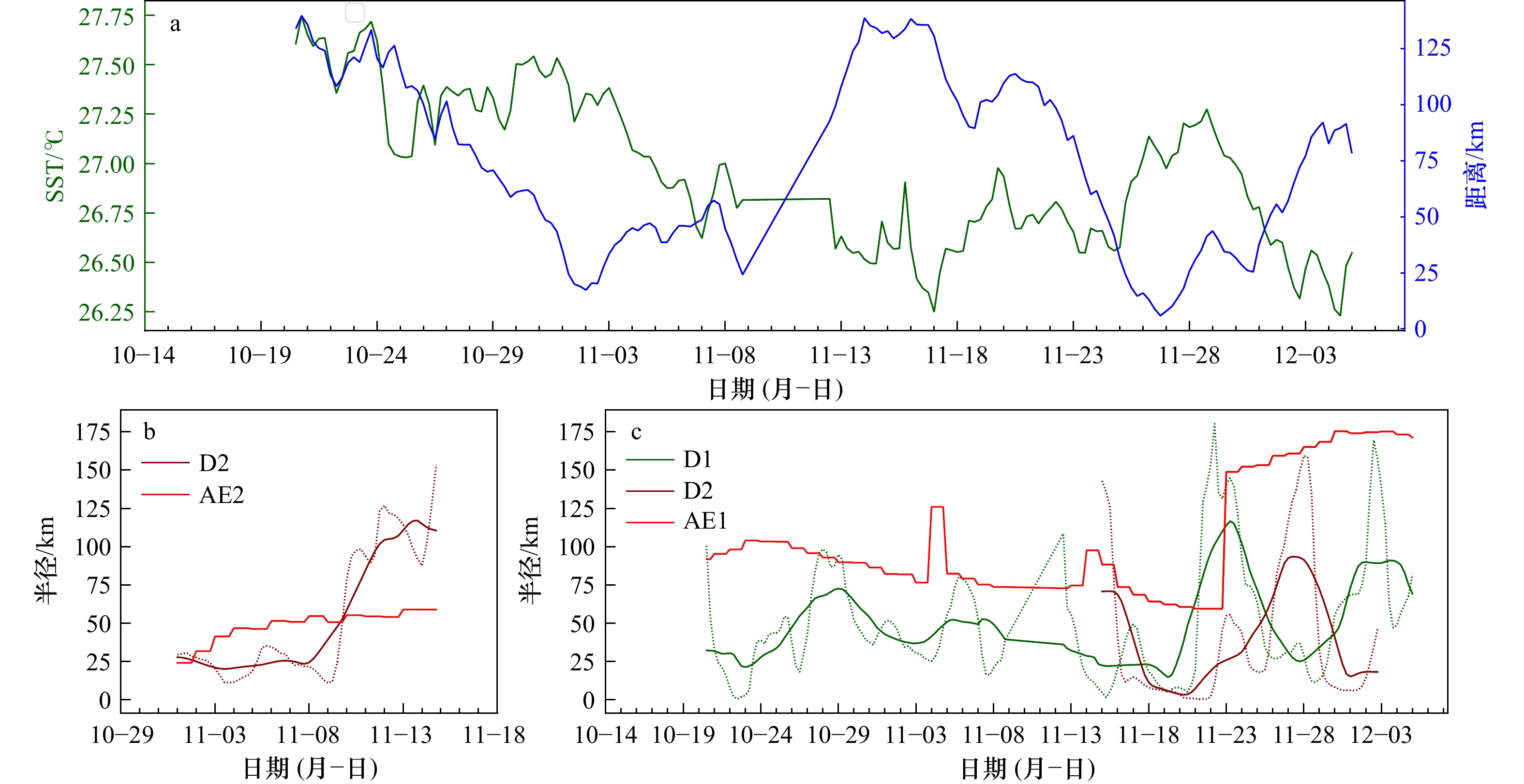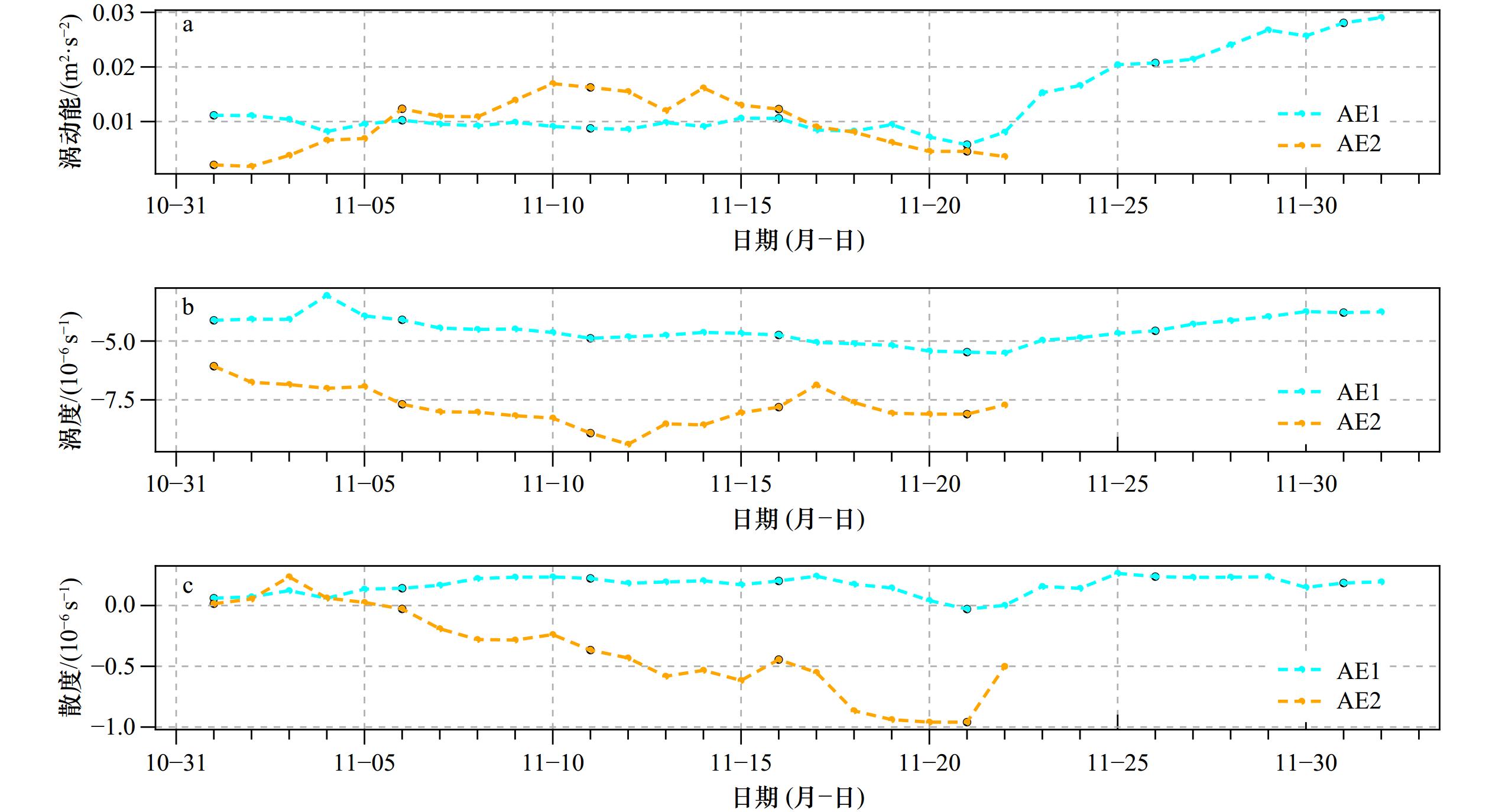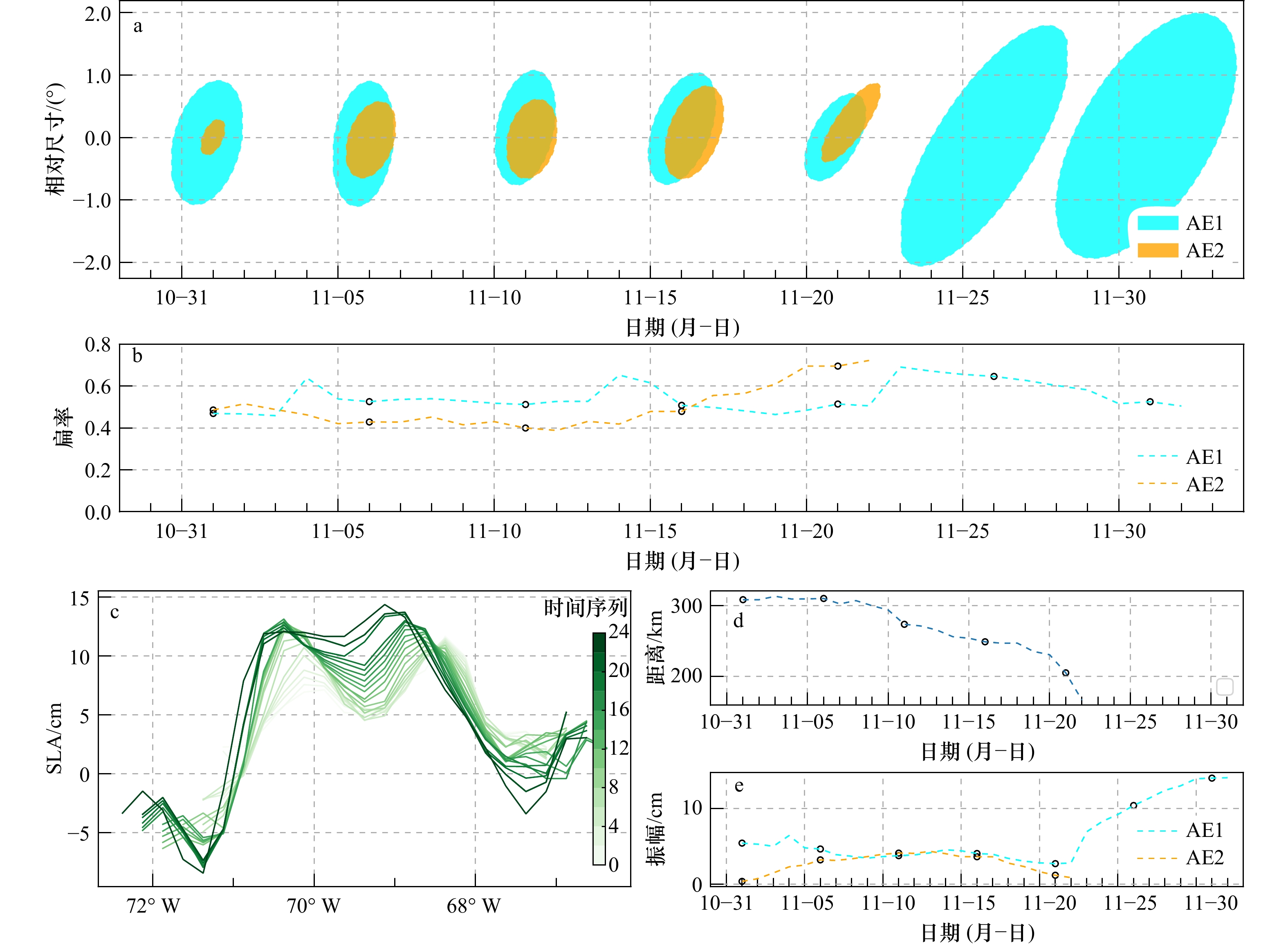Investigating the anticyclonic eddy merger process in southeastern Gulf of Mexico using altimeter and drifting buoy
-
摘要: 本文结合卫星高度计和漂流浮标数据,采取海表面高度法发现并跟踪了墨西哥湾东南部附近发生的一次暖涡融合事件,通过该典型暖涡融合过程的研究初步揭示了涡间融合作用模式,有助于进一步理解复杂涡旋作用机制。欧拉涡旋结果显示,一对暖涡彼此吸引并伴随传播3周以上,随后融合为统一涡旋结构并继续向西传播。被其捕获的浮标提供了融合前后的拉格朗日涡旋轨迹,在融合发生前8天时,一个浮标随水流交换切换了原本追随的暖涡,表明融合事件被高度计观测到之前,涡间水体交流作用已经比较显著。融合前后,欧拉涡旋和拉格朗日涡旋半径均存在较大改变,其中欧拉半径提升了96.2%,受两个暖涡牵引的漂流浮标的拉格朗日半径分别提升了49.1%和115.6%。受融合效应影响,海表面温度场也表现出不同的环境响应,进一步验证了融合过程的发生。最后,对融合前后动能、涡度和散度等动力学演变,以及半径、振幅和形状等形态学变化的分析表明:融合大致经历了涡旋渐近、水体交流、轮廓压缩形变、拉长椭圆涡旋生成和边界重塑等过程;涡心所在平面的垂直结构主要表现为由双峰向单峰的演变;涡旋融合后实现了能量向中尺度的逆级联;受限于单核涡结构,在融合过程中部分属性统计存在偏差,可能导致事件前后发生突变。Abstract: Combining satellite altimetry and drifter data, the method of sea surface height to discover and track an anticyclonic eddy merger event that occurred near the southeastern Gulf of Mexico was used in this study. By studying this typical anticyclonic eddy merger process, the mode of eddy merging is preliminarily revealed, which helps to further understand the complex eddy mechanism. The Eulerian eddy results show that pairs of anticyclonic eddies attract each other and propagate together for more than three weeks before merging into a unified eddy structure and continuing to propagate westward. The Lagrangian vortex trajectories captured by drifters provide evidence of water exchange between the vortices before the merger, as one drifter exchanged its original anticyclonic eddy on November 15, indicating significant water exchange between the vortices before being observed by the altimeter. Before and after the merger, the radii of the Eulerian and Lagrangian vortices both increased significantly with the Eulerian radius improving by 96.2% and the Lagrangian radius of the drifting buoys pulled by two anticyclonic eddies improving by 49.1% and 115.6%, respectively. The sea surface temperature field also exhibited different environmental responses due to the merging effect, further verifying the occurrence of the merger process. Finally, the analysis of the dynamic evolution of kinematics such as kinetic energy, vorticity, and divergence before and after the merger, as well as the morphological changes such as radius, amplitude, and shape, showes that the merger roughly experienced processes such as vortex asymptote, water exchange, contour compression and deformation, elongated elliptical vortex generation, and boundary reshaping. The vertical structure of the plane where the vortex is located mainly shows evolution from bimodal to unimodal. After the vortex merger, energy is transferred to the mesoscale through inverse cascade. Due to the single-core vortex structure, some statistical properties are biased during the merging process, which may have led to abrupt changes before and after the event.
-
Key words:
- anticyclonic eddy /
- eddy merger /
- satellite altimetry /
- drifting buoy
-
图 1 浮标轨迹(a)及涡旋演变(b−f)
a. 颜色由浅及深表示时间序列,粗圆点为起始位置,粗叉号为结束位置;b−f时间依次为11月7日、11月15日、11月22日、11月23日、11月30日
Fig. 1 Eddy merge evolution and buoy trajectory
The colors in a from light to dark indicate the time series, the thick dots are the starting positions, and the thick crosses are the ending positions; the dates of b−f are November 7th, 15th, 22nd, 23rd and 30th in order
图 2 AE2捕获下D2轨迹(a)、融合前AE1捕获下D1、D2轨迹(b)、融合后AE1捕获下D1、D2轨迹(c)和前期D2轨迹(d)及速度演化过程(e)
a−d中轨迹线段宽度表示漂流浮标速度,颜色由浅及深表示时间序列(其值代表这条轨迹的第几天),由于浮标数据的时间分辨率为6 h,故序列长度大于时间天数;e中虚线为原始数据,实线为滤波后结果;a、b、c中黑点表示原点
Fig. 2 D2 trajectories under AE2 capture (a), D1 and D2 trajectories under AE1 capture before fusion (b), D1 and D2 trajectories under AE1 capture after fusion (c), pre-D2 trajectories (d) and velocity evolution process (e)
The width of the trajectory segment in a−d indicates the buoy velocity, and the color from light to dark indicates the time series (its value represents the day of this trajectory). Because of the 6 h temporal resolution, the length of the series is larger than the time days; the dashed line in e is the original data, and the solid line is the filtered result; the black dots in a, b, c represent the coordinate origin
图 3 浮标近海SST及到涡心距离演变(a)和涡旋半径演变(b, c)
b. 对应D2拉格朗日半径和AE2欧拉半径;c. 对应D1、D2拉格朗日半径和AE1欧拉半径,图中虚线为原始值,实线为平滑值
Fig. 3 Evolution of the buoy SST and its distance to the eddy core (a), and evolution of the eddy radius (b, c)
b. Corresponds to D2 Lagrangian radius and AE2 Eulerian radius; c. corresponds to D1, D2 Lagrangian radius and AE1 Eulerian radius, the dashed line in the figure is the original value and the solid line is the smoothed value
图 4 涡旋附近海域SST异常场变化
a−d日期依次为11月15日、11月22日、11月23日、11月30日;e−g中红点代表涡心位置,黑线代表等效半径的位置,值为无量纲单位;e−g分别对应AE2(11月1−22日)、融合前AE1(10月13日至11月22日)和融合后AE1(11月23日至12月5日)的归一化结果
Fig. 4 Status of SST abnormal field near the eddy
a−d dates are November 15th, 22nd, 23rd and 30th, respectively; the red dots in e−g represent the position of the eddy core and the black lines represent the position of the equivalent radius, and the values are dimensionless units; e−g correspond to the normalization results for AE2 (November 1st to 22nd), pre-fusion AE1 (October 13rd to November 22nd) and post-fusion AE1 (November 23rd to December 5th) respectively
-
[1] Morrow R, Le Traon P Y. Recent advances in observing mesoscale ocean dynamics with satellite altimetry[J]. Advances in Space Research, 2012, 50(8): 1062−1076. doi: 10.1016/j.asr.2011.09.033 [2] Chelton D B, Schlax M G, Samelson R M. Global observations of nonlinear mesoscale eddies[J]. Progress in Oceanography, 2011, 91(2): 167−216. doi: 10.1016/j.pocean.2011.01.002 [3] Zhang Zhengguang, Wang Wei, Qiu Bo. Oceanic mass transport by mesoscale eddies[J]. Science, 2014, 345(6194): 322−324. doi: 10.1126/science.1252418 [4] Faghmous J H, Frenger I, Yao Yuanshun, et al. A daily global mesoscale ocean eddy dataset from satellite altimetry[J]. Scientific Data, 2015, 2(1): 150028. doi: 10.1038/sdata.2015.28 [5] Huang M J. The physical mechanism of symmetric vortex merger: a new viewpoint[J]. Physics of Fluids, 2005, 17(7): 074105. doi: 10.1063/1.1949647 [6] Herbette S, Morel Y, Arhan M, et al. Erosion of a surface vortex by a seamount on the β plane[J]. Journal of Physical Oceanography, 2005, 35(11): 2012−2030. doi: 10.1175/JPO2809.1 [7] Le Vu B, Stegner A, Arsouze T. Angular momentum eddy detection and tracking algorithm (AMEDA) and its application to coastal eddy formation[J]. Journal of Atmospheric and Oceanic Technology, 2018, 35(4): 739−762. doi: 10.1175/JTECH-D-17-0010.1 [8] Reinaud J N, Dritschel D G. The critical merger distance between two co-rotating quasi-geostrophic vortices[J]. Journal of Fluid Mechanics, 2005, 522: 357−381. doi: 10.1017/S0022112004002022 [9] Nielsen A H, He Xinyu, Rasmussen J J, et al. Vortex merging and spectral cascade in two-dimensional flows[J]. Physics of Fluids, 1996, 8(9): 2263−2265. doi: 10.1063/1.869027 [10] Rodríguez-Marroyo R, Viúdez Á, Ruiz S. Vortex merger in oceanic tripoles[J]. Journal of Physical Oceanography, 2011, 41(6): 1239−1251. doi: 10.1175/2011JPO4582.1 [11] Fang Fangxin, Morrow R. Evolution, movement and decay of warm-core Leeuwin Current eddies[J]. Deep Sea Research Part II: Topical Studies in Oceanography, 2003, 50(12/13): 2245−2261. [12] Pavia E G, Cushman-Roisin B. Merging of frontal eddies[J]. Journal of Physical Oceanography, 1990, 20(12): 1886−1906. doi: 10.1175/1520-0485(1990)020<1886:MOFE>2.0.CO;2 [13] Oulhen E, Reinaud J N, Carton X. Formation of small-scale vortices in the core of a large merged vortex[J]. Geophysical & Astrophysical Fluid Dynamics, 2022, 116(5/6): 411−432. [14] Masina S, Pinardi N. The halting effect of baroclinicity in vortex merging[J]. Journal of Physical Oceanography, 1993, 23(8): 1618−1637. doi: 10.1175/1520-0485(1993)023<1618:THEOBI>2.0.CO;2 [15] Reinaud J N, Dritschel D G, Scott R K. Self-similar collapse of three vortices in the generalised Euler and quasi-geostrophic equations[J]. Physica D: Nonlinear Phenomena, 2022, 434: 133226. doi: 10.1016/j.physd.2022.133226 [16] Nan Feng, He Zhigang, Zhou Hui, et al. Three long-lived anticyclonic eddies in the northern South China Sea[J]. Journal of Geophysical Research: Oceans, 2011, 116(C5): C05002. [17] Yi Jiawei, Du Yunyan, Zhou Chenghu, et al. Automatic identification of oceanic multieddy structures from satellite altimeter datasets[J]. IEEE Journal of Selected Topics in Applied Earth Observations and Remote Sensing, 2015, 8(4): 1555−1563. doi: 10.1109/JSTARS.2015.2417876 [18] Cui Wei, Wang Wei, Zhang Jie, et al. Multicore structures and the splitting and merging of eddies in global oceans from satellite altimeter data[J]. Ocean Science, 2019, 15(2): 413−430. doi: 10.5194/os-15-413-2019 [19] Li Qiuyang, Sun Liang, Lin Shengfu, et al. GEM: a dynamic tracking model for mesoscale eddies in the ocean[J]. Ocean Science, 2016, 12(6): 1219−1267. [20] Lumpkin R, Pazos M. Measuring surface currents with Surface Velocity Program drifters: the instrument, its data, and some recent results[M]//Griffa A, Kirwan A D, Mariano A, et al. Lagrangian Analysis and Prediction of Coastal and Ocean Dynamics. Cambridge: Cambridge University Press, 2007. [21] Lumpkin R. Global characteristics of coherent vortices from surface drifter trajectories[J]. Journal of Geophysical Research: Oceans, 2016, 121(2): 1306−1321. doi: 10.1002/2015JC011435 [22] Dong Changming, Liu Yu, Lumpkin R, et al. A scheme to identify loops from trajectories of oceanic surface drifters: an application in the kuroshio extension region[J]. Journal of Atmospheric and Oceanic Technology, 2011, 28(9): 1167−1176. doi: 10.1175/JTECH-D-10-05028.1 [23] 董昌明, 蒋星亮, 徐广珺, 等. 海洋涡旋自动探测几何方法、涡旋数据库及其应用[J]. 海洋科学进展, 2017, 35(4): 439−453. doi: 10.3969/j.issn.1671-6647.2017.04.001Dong Changming, Jiang Xingliang, Xu Guangjun, et al. Automated eddy detection using geometric approach, eddy datasets and their application[J]. Advances in Marine Science, 2017, 35(4): 439−453. doi: 10.3969/j.issn.1671-6647.2017.04.001 [24] Mason E, Pascual A, Mcwilliams J C. A new sea surface height-based code for oceanic mesoscale eddy tracking [J]. Journal of Atmospheric and Oceanic Technology, 2014, 31(5): 1181–1188. [25] Henson S A, Thomas A C. A census of oceanic anticyclonic eddies in the Gulf of Alaska[J]. Deep-Sea Research Part I: Oceanographic Research Papers, 2008, 55(2): 163−176. doi: 10.1016/j.dsr.2007.11.005 [26] Penven P, Echevin V, Pasapera J, et al. Average circulation, seasonal cycle, and mesoscale dynamics of the Peru Current System: a modeling approach[J]. Journal of Geophysical Research: Oceans, 2005, 110(C10): C10021. [27] Chaigneau A, Pizarro O. Eddy characteristics in the eastern South Pacific[J]. Journal of Geophysical Research: Oceans, 2005, 110(C6): C06005. [28] 赵新华, 侯一筠, 刘泽, 等. 基于卫星高度计和浮标漂流轨迹的海洋涡旋特征信息对比分析[J]. 海洋与湖沼, 2019, 50(4): 759−764.Zhao Xinhua, Hou Yijun, Liu Ze, et al. Analysis of the global eddies based on altimeter snapshots and buoy drifting trajectory data[J]. Oceanologia et Limnologia Sinica, 2019, 50(4): 759−764. [29] Chen Ge, Han Guiyan, Yang Xueqing. On the intrinsic shape of oceanic eddies derived from satellite altimetry[J]. Remote Sensing of Environment, 2019, 228: 75−89. doi: 10.1016/j.rse.2019.04.011 [30] 彭汉帮, 王金虎, 吴克亮, 等. 基于海洋调查实测资料的中尺度涡旋识别结果的验证及边界拟合技术[J]. 海洋学报, 2021, 43(1): 61−68.Peng Hanbang, Wang Jinhu, Wu Keliang, et al. Verification and fitting for the results of mesoscale eddy detection based on the observed data[J]. Haiyang Xuebao, 2021, 43(1): 61−68 [31] Belkin I, Foppert A, Rossby T, et al. A double-thermostad warm-core ring of the gulf stream[J]. Journal of Physical Oceanography, 2020, 50(2): 489−507. doi: 10.1175/JPO-D-18-0275.1 -





 下载:
下载:





